Wouldn’t it be great if you could attract more visitors from around the world to your website and increase traffic?
As the president of a popular WordPress SEO plugin, I’ve seen a growing trend toward the need for localization (adapting your content to a specific target audience) on websites and in online marketing.
I believe that many businesses can unlock tremendous potential by combining basic localization techniques with SEO best practices.
In this article, I will share proven international SEO tips that have helped me and many others, including entrepreneurs, marketers, and bloggers, to attract a global audience.
Note: This is a guest post by Benjamin Rojas, the president of All in One SEO, the best WordPress SEO plugin on the market. This is an expert column that we publish on Thursdays, where we invite a WordPress expert to share their experiences with our readers.
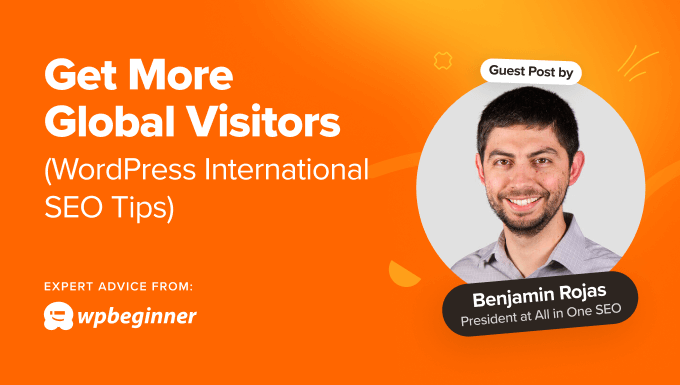
I will break down the article into step-by-step tips that you can use. If you want, you can also jump to a section by clicking the links below:
Why Target Global Audiences With International SEO?
As the president of one of the biggest WordPress SEO plugins on the market, I have customers from all over the world.
To earn these customers, my team ensures that All in One SEO can be translated easily (50+ languages and counting).
This is just one way to get more global customers, and there are plenty of ways that other businesses can do it.
Here are some of the benefits of targeting global audiences:
- More traffic: Anyone from anywhere can visit your website. Why limit yourself? Going international means your audience can explode in size.
- Understand broader customer needs: It’s not just about getting hits. It’s about understanding what different people need and want. This can help you tailor your content and marketing to convert more users.
- Boost engagement: When you speak someone’s language, literally and culturally, they’re more likely to listen. That means more shares, more sales, and more feedback.
- Stay ahead of competitors: Many businesses aren’t making the most of international SEO yet. Start now, and you’ll be steps ahead.
How to Target Users in Different Regions With International SEO
Over the years working in the SEO industry, I have learned that tiny changes in your SEO strategy can often lead to big and meaningful results.
One misconception about offering localized experiences is that it requires too much time and resources.
My experience has been totally different.
International SEO does require some effort, but it is quite easy, and the benefits are worth your time.
1. Choose Regions You Want to Target
Not all businesses and websites target international audiences.
However, for most websites, a huge chunk of visitors are coming from abroad, even when you are not specifically trying to reach any region in particular.
That’s not to say that you have to make your website available in every language. However, you can determine and target which languages and regions are the easiest low-hanging fruit.
The perfect tool for this is Google Analytics. It tracks your website visitors and shows you who they are, where they are coming from, and what they are interested in.
Many users have reported difficulty finding the reports they need in Google Analytics. I recommend that you use MonsterInsights, which is the best Google Analytics plugin for WordPress.
I use MonsterInsights because it makes Google Analytics so easy. You get all your important reports right inside the WordPress dashboard.
For instance, you get this ‘Top 10 Countries’ report showing where your visitors come from.
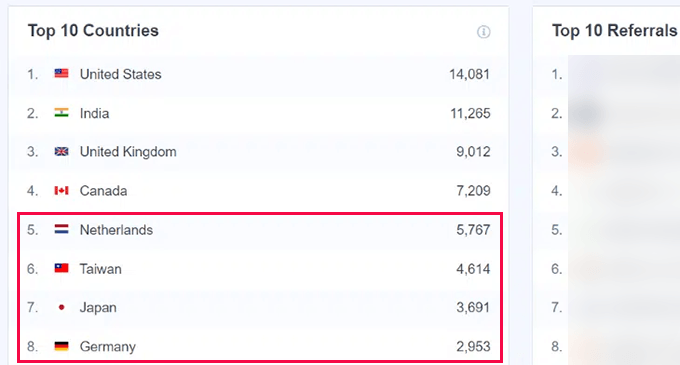

In this example screenshot, you can easily see countries where most people speak a language different than your website’s language.
You also see countries where users may speak the same language but have regional differences, such as currencies and cultural and geographical factors.
Reaching those customers by providing them with a more localized experience can bring in more users and revenue from these regions.
For more details, you can read this guide on how to track visitors to your WordPress website.
2. Translating Websites into Local Languages
Once you have found the regions you want to target, translating your website into local languages is the easiest way to offer a better user experience.
Only a decade ago, creating multilingual websites was not easy. However, now you have excellent tools and resources that make it a breeze.
The easiest way to serve multilingual content in WordPress is by using a WordPress translation plugin like WPML.
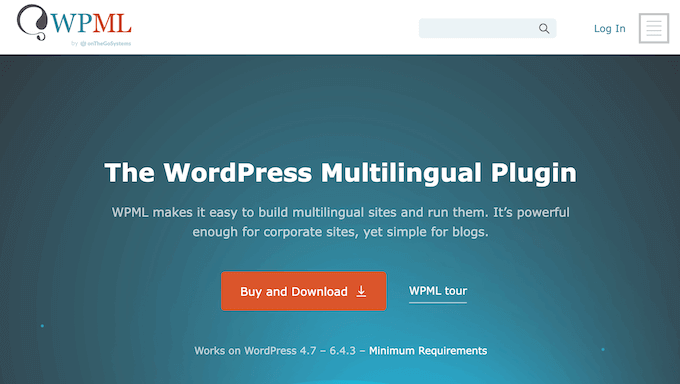

It is one of the best translation plugins for WordPress and allows you to create a multilingual WordPress website easily.
You can translate your website by yourself or outsource translations. It is not too expensive, and the quality of human translations is typically high.
WPML also offers AI-powered automatic translations on a pay-as-you-go basis. It is built using state-of-the-art language models from Microsoft, Google, and DeepL.
Alternatives: MultilingualPress and TranslatePress
What Should You Translate?
The big question that comes next is whether you should translate a select few pages or your entire website.
From an SEO point of view, here is how I see it:
Translating just a handful of pages means you’re missing out on ranking opportunities in other languages. Having a higher number of translated pages creates more chances to climb the search engine ladder.
Remember, internal linking is a major player in SEO. To make it work on a multilingual site, you need enough translated content to create meaningful links between pages.
So, my advice is: Go for a full site translation. This will boost your SEO and enhance the user experience, which search engines love.
3. Choose URL Structure
When offering different versions of a website to different regions, your WordPress translation plugin will ask you to choose a URL structure.
You can use any of the following URL structures:
- Subdomain URL structure (Example: https://en-uk.yourwebsite.com). The disadvantage of this method is that search engines consider subdomains to be individual websites. Your root domain will not benefit from this structure.
- Subdirectory URL structure (Example: https://yourwebsite.com/en-uk/) This URL structure takes advantage of your root domain’s authority and is good for rankings in many cases.
- Country-level domain names (Example: https://yourwebsite.co.uk). For this method, you will need to register domain names for each country you want to target. The advantage is that ranking in a country with a local domain name is easier. The disadvantage is that this will be treated as a standalone website with little benefit to your main domain name.
- Language parameter in URL (Example: https://yourwebsite.com/?lang=en-gb). This method is not recommended because it makes it difficult for you to manage URLs and for users to realize they are seeing a geo-targeted page version.
In my opinion, a subdirectory URL structure offers the most SEO benefits for small businesses. It is also easier to manage and set up redirects.
4. Keyword Research
Keyword research is the technique used by SEO experts and marketers to find the search terms their target audience is using.
It applies to international SEO as well.
For example, while your website might rank for “Sneakers” in the United States, in the UK, your customers could be searching for “Trainers,” and in Canada, they might use the term “Runners.”
You can see this in action on the Nike website. It has highly optimized pages for ‘Trainers’ on the Nike U.K. store, ‘Sneakers’ on the Nike U.S. store, and ‘Shoes’ on Nike India.
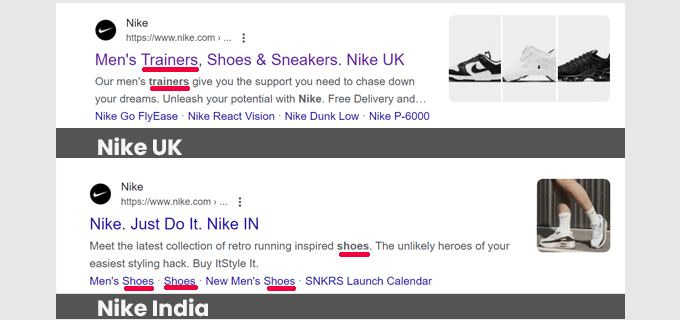

You can select countries while doing your keyword research to find the search volume.
I recommend using SEOBoost for keyword research. It is an all-in-one tool for on-page SEO and keyword research.
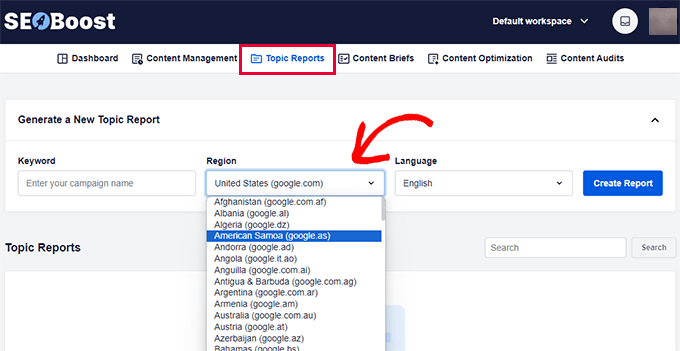

Simply enter your main keyword and then select the region you want to target.
It will generate a comprehensive analysis of search rankings, content analysis, and what you need to outrank the competition.
Alternative Tools: Semrush, LowFruits, WPBeginner Keyword Generator
If you haven’t done keyword research before, then you may find WPBeginner’s keyword research tutorial a solid starting point.
5. Optimizing Pages for Multi-Regional SEO
I have seen many businesses beating the competition with effective on-page optimization.
This becomes even more important if you are offering multilingual content targeting different regions.
This is where your WordPress SEO plugin comes in handy.
You will need an SEO plugin like All in One SEO, which helps you optimize each page with different SEO titles and descriptions.
Aside from the copy on your page, post, or product content, you will need to pay attention to SEO settings.
Depending on which translation plugin you are using, you can edit the SEO settings in the translation editor. For example, here is the WPML translation editor, where the AIOSEO settings are highlighted.
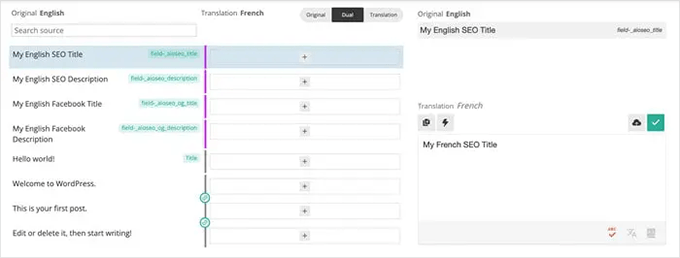

Ensure you optimize each page for the focus keyword you chose for that region.
Basically, you will repeat the steps to optimize your blog posts for SEO but for a different locale and region.
Submit Multilingual Sitemaps
Once you have started translating your content into other languages, you need to tell search engines about the translated content.
The best way to do this is with XML sitemaps. These documents tell search engines about all the content on your website, which makes it easier for them to crawl and rank your posts and pages.
If you are using All in One SEO for WordPress, then you can go to the AIOSEO » Sitemaps page to configure sitemaps.
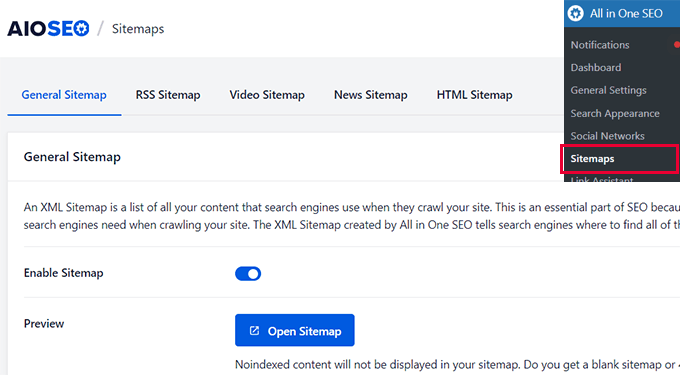

All in One SEO replaces the default WordPress XML sitemaps with advanced features. It automatically includes all your translated content in your sitemaps and even supports RSS, video, news, and HTML sitemaps.
After that, you can go ahead and submit your sitemap to Google Search Console.
Create Multilingual Landing Pages and Homepages
Unfortunately, many businesses often overlook their landing and home pages when thinking about regional user experience.
Including cultural references and location-specific content on your pages can help with conversions. However, overlooking these elements may cause your landing and home pages for different regions to be less effective in converting traffic into customers.
I recommend creating pages using a page builder like SeedProd. It is a beginner-friendly WordPress page builder with an intuitive drag-and-drop design tool.
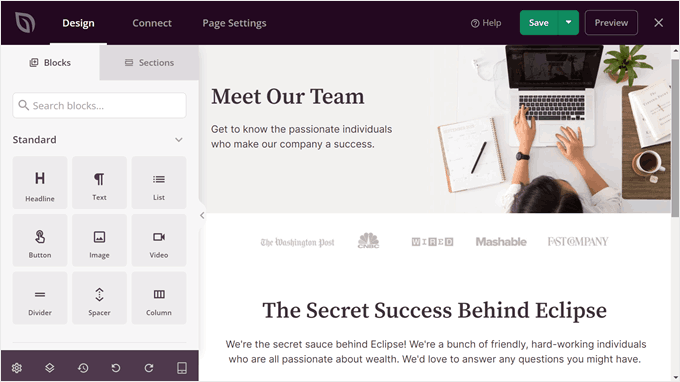

This way, you can easily create duplicate landing pages and translate them. You can also create separate home pages for different regions.
Basically, this approach significantly reduces the amount of work required without compromising on conversions.
6. Redirecting Users to Regional Content
In my experience, a personalized user experience is great for conversions. For that reason, you might be considering automatically sending users to content made for their region and language.
That’s a big NO!
Google and other search engines discourage setting up automatic redirects for translated versions of your website by detecting users’ IP addresses or cookies.
This is because automatic redirects may stop search bots from crawling all versions of your site and prevent users from viewing content they originally found.
Instead, it’s better to set up a language or region switcher for your multilingual and multi-region content. This will inform users that the content is available in their language or region and give them an opportunity to switch.


Note: All top WordPress translation plugins come with language switchers.
What About Manual Redirects?
In some cases, you may need to set up manual redirects. For instance, if you change the URL structure from a subdomain to a directory URL.
These types of redirects may be necessary because the old URL structure would result in 404 errors.
You can use the All in One SEO redirection manager to set those redirects. It lets you set up site redirects and use REGEX to save time.
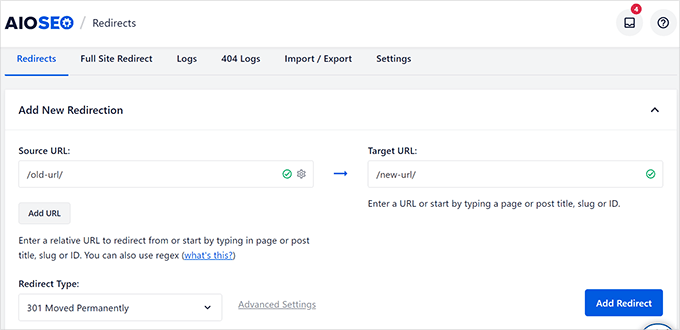

Alternatively, you can use the free Redirection plugin to set up redirects. For instructions, see how to set up redirects in WordPress.
7. Let Google Know About Different Versions
Google is pretty good at detecting content in different languages and showing it to users in those regions. However, I still recommend explicitly telling search engines about the language or region of your content.
This can be done using the hreflang HTML tag. Most WordPress translation plugins will automatically add that to the header of your site. It is a tiny string that looks like this:
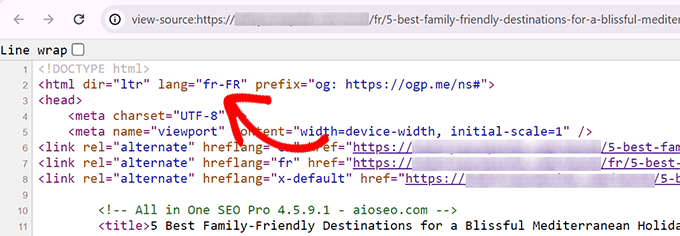

Why Is It Important?
Let’s say you have three versions of a page, all in English, but they show prices in regional currencies.
The content of those pages may appear quite similar to search engines and could be considered duplicate content.
By adding the hreflang tag to the HTML code, you tell search engines about the different versions of the page to avoid duplicate content.
I hope this article helps you attract a more global audience with your international SEO strategy. You may also want to check out whether AI content is bad for SEO or look at these case studies of websites that doubled their traffic in 6 months.
If you liked this article, then please subscribe to our YouTube Channel for WordPress video tutorials. You can also find us on Twitter and Facebook.

